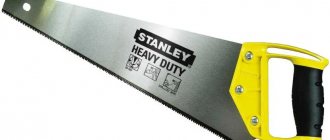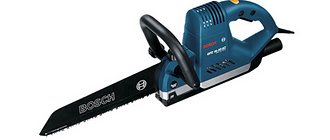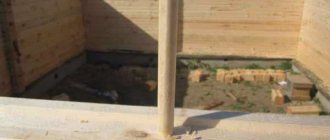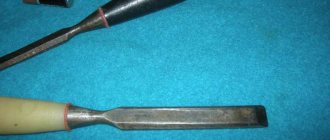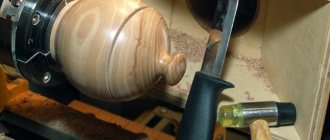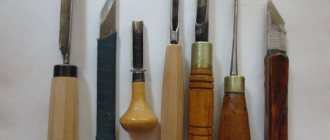Chisel device
The working part of the tool is a blade made of durable metal, at the end of which there is a blade. They allow you to perform the above functions. On the opposite side, the metal part takes the form of a rod onto which the handle is mounted. At the junction of the handle and the metal part of the tool there is a special metal cap. It protects the handle from damage that may occur during operation.
Chisels can be hand or impact. In the first case, the tool works due to hand pressure on it, and in the second - due to blows with a mallet on the end part. To ensure that the wooden handle does not deform from impacts, a special metal ring is provided at the end of the impact chisels.
Types of chisels and their prices
The names of chisels almost completely determine their features and the nature of the work for which they are intended.
This is how a chisel for working wood is:
- Manual - cutting into the material occurs from hand pressure on the handle.
- Impact - cutting into the material occurs by applying light blows with a mallet to the end of the handle, which has a metal butt plate.
A classic chisel has a shaft length of 150–170 mm, while a shortened one has a shaft length of 65–85 mm.
The following chisels are distinguished by purpose:
Carpentry
For fine and precise processing of workpieces, for example, a figured chisel, which allows you to carve hard and soft wood.
The latter include spruce, poplar, and linden.
Plotnitskaya
For rough, rough processing of workpieces of various types of wood.
Turning
For manual processing of parts rotating in a lathe, they are more often called turning tools.
According to the shape of the longitudinal section of the blade, the chisel can be:
Straight
The most common option is with a straight blade and blade, like a ruler.
Curved
With a longitudinal bend of the entire blade and blade.
Klukarza
With a sharp bend of the blade in the longitudinal direction, the beginning of which is located almost at the end of the straight blade. Used, for example, when cutting into door locks.
If the blade of the tool is sharpened on the reverse side, the corresponding classifier word is added to the name, for example, reverse cranberry.
By the way, reversible blades allow you to create convex parts of decorative relief.
According to the cross-sectional shape of the canvas, the chisel can be:
Flat
With a straight flat cross profile. It can be both wide and narrow, thick and thin (according to the parameters of the canvas).
The shape of the blade can be either oblique or straight. In the latter case, the cutting edge is perpendicular to the blade. Used for rough processing and creating straight lines.
Oblique
The previous version has a cutting edge that is beveled relative to the perpendicular to the blade.
This angle of attack makes it easier to cut into the wood base, increasing roughing speed.
Corner
The transverse profile is made in the shape of an angle (the letter “V”). The angle itself, as a rule, is between 60 and 90 degrees.
With such a tool you can make contour and relief carvings, and they can also be used to assign the contour of the future workpiece.
Radial
The cross section is made in the shape of a semicircle. Hence another name - semicircular chisel.
It is designed to perform accurate and smooth penetration into the material, which is probably why it is considered the most popular and in demand.
Such models are used for carving along a contour that has unevenness, where there are no sharp or right angles. The cutting part comes in two shapes: flat and sloping, and can also have a different radius of curvature.
Bracket (box-shaped)
The cutting edge is straight, with sides of different heights and different angles between these elements.
Suitable for even, narrow samples of material.
Cerasik
In structure it is close to the semicircular varinate, but has a significantly smaller thickness. This figured tool is used in artistic carving.
The cost of the types of tools described above is not too different from each other.
As a rule, the average price is 300 – 700 rubles per unit, and it depends, first of all, on the quality of the materials and the brand itself.
So there are models costing 1,300 rubles and more.
At the same time, the promotion of the manufacturer’s company affects pricing not in the least.
For comparison, a set of “Tatyanka” chisels for hand carving made of U10A steel (made by milling, 12 elements included) with a beech handle will cost about 10,000 rubles, that is, approximately 800 rubles each. a piece.
At the same time, Japanese ones are produced using a manufacturing technology different from traditional ones (two-layer steel with a hardness of 60 HRc), with a handle made of Japanese red oak.
For a similar set from Hattori (10 pieces) you will have to pay about 12 - 13 thousand rubles, which is already 1200 - 1300 rubles per piece.
However, the latter can be sharpened to razor sharpness.
Sets with more tools, of course, cost more.
In addition to tools for wood processing, there are options for work:
- For metal - an impact version of the tool with a specific sharpening configuration that allows you to process soft metals, for example, aluminum.
- For stone - a percussion tool, used for chipping material. A stone chisel is also suitable for giving the workpiece a fine faceted shape.
- For concrete - actually a chisel, but with a different configuration of the working part, including a semicircle. In most cases, it has a pobedite solder and acts as an attachment for a hammer drill.
Electric chisel
Along with the usual tool, they actively use its electrical modification, which is called an electric chisel, also known as a renovator.
The working element is a special attachment made in the form of already familiar chisels, which is selected depending on the type of work.
This universal machine is also called an electric chisel, multi-cutter or electric scraper.
The electric chisel has high performance and allows you to perform precise fine carvings.
The cost of such models is 5 – 9 thousand rubles.
In turn, it happens:
- Network - powered from a household network.
- Rechargeable – powered by a removable battery.
In addition to standard ones, there are also special chisels:
Surgical
The instrument used in medicine is made of surgical steel.
Vivid examples are the otolaryngological chisel for rhinoplasty and the Vojacek grooved chisel, which is used for trephination of the mastoid process using the hammerless method.
Pasichnaya
A tool for the daily work of a beekeeper.
A multifunctional chisel with a nail puller function and devices for lifting glued frames is called “European”.
Price – about 300 rubles.
For loops
A specially designed tool designed for knocking out rounded corners of seats for door hinges and locks after they have been milled. It is also called a corner chisel, but structurally it is very different from the tool of the same name described above.
The domestic modified version is the chisel of Pavel Soldatov, named, in fact, by the manufacturer.
The cost of the latter is around 3,400 rubles.
Plastic
For repairing car wheels, or more precisely, for cleaning protrusions, removing bumps and burrs from the tire.
An alternative name is a chisel-scraper.
Essentially an exact replica of a flat, straight instrument, but made entirely of plastic.
Price – about 200 rubles.
An option that resembles a multitool in design, however, without additional tools.
In fact, this is a folding chisel, where, when folded, the blade is located between the halves of the handle.
This allows you to safely transport and store the tool, for example in a pocket or bag.
Cost – from 600 rubles.
Mini chisel
A miniature version of a full-size tool, mainly used for fine carving on soft materials.
Beweiler (Beveller)
A flat-cut tool designed to thin leather at folds.
Alternative names are edge cutter or French chisel.
Cost – from 200 rubles.
Chisel-chisel
A percussion type of tool used to gouge out excess parts of material.
Chisel-jamb
Power sculpture knife (jamb knife) designed for relief geometric carving.
Each of the wood processing tools listed above has its own area of application, and therefore to create just one decorative relief you may need up to 10 different types of it, also of different sizes.
Types of chisels
Based on their purpose, the following main types of chisels can be distinguished:
- carpentry;
- carpentry;
- turning
The carpenter's chisel is used for performing fine and precise work, the carpenter's chisel is used for rough processing, and the turning chisel is used for working on the machine.
Based on the shape of the longitudinal section of the working part, straight, angular and cranberry are distinguished. The latter has significant bends and is most often used for cutting locks into wooden doors.
Based on the cross-sectional shape of the working part, you can find an angular chisel, a flat chisel, an oblique chisel, a staple chisel, as well as a semicircular chisel and a cerasic chisel (semicircular with a minimum thickness).
There are also chisels for medical purposes, they are called surgical and are made of special medical steel. Some beekeepers also use similar tools called apiary tools.
Purpose of the chisel
When talking about chisels, we are usually talking about woodworking cutting tools.
Its versatility is expressed in a large number of jobs performed, including making recesses, cleaning grooves, chamfering, applying contour and relief carvings.
In addition, the tool is used for planing, and more specifically, for removing material of small thickness.
Electric chisel
In addition to the familiar appearance of this tool, recently an electric chisel has become increasingly popular, which is practically a portable woodworking machine reduced to the convenient size of a hand tool.
This is a universal device, which is an electric motor that drives the nozzles. The attachments are replaceable and selected based on the task at hand. Compared to a conventional chisel, the electric version shows higher productivity and accuracy. Many advantages make such devices very popular at the moment. For greater convenience, models have been developed that are equipped with batteries and can work without being connected to the network.
Chisels for carving. Classification
A chisel is a professional tool for a carpenter or joiner, used to prepare wooden pieces for further processing. It will help to chamfer and apply carving patterns by removing excess layers of wood. The design of the chisel is very simple - it has a plastic or wooden handle and a sharpened blade of various shapes.
The following types of chisels exist:
- a straight chisel is needed for processing wooden blanks and cutting simple recesses
- an oblique chisel has a blade that is beveled at an angle of 450. It is used for cutting longitudinal grooves, as well as work related to the primary processing of the workpiece
- an angular chisel is similar to the English letter V, 2 closed planes of the blade are at different angles. It is necessary to create V-shaped notches. The sharper and shallower the angle of the cutter, the deeper the cutter will get
- A semicircular chisel for wood is perhaps the most important type of this tool. With this semicircular tool, the product is prepared, and ornaments of varying complexity are cut out and serifs are applied. The semicircular chisel can be round, medium or sloping
- cranberry is very similar to a semicircular chisel. The main difference is that its working surface is rounded not only along the end of the blade, but also along the shaft. This shape guarantees a clearer movement of the tool on wood. Cranberries are different. Their cutting part can be rounded, angular or straight
- Caesars can also be called a type of semicircular chisel, but they have a narrower working part, only 3 mm in width. Their main purpose is to cut thin grooves and work out the smallest details of the ornament.
- The gravers have a mushroom-shaped handle and an oblique cutter. They are mainly used for cutting grooves. With increasing pressure from the master, the carving becomes clearer and deeper
- A rivet is a mini-chisel for wood, which has a thin sharpening of a narrow blade, similar to a sharp leaf. This tool is used when ordinary chisels cannot create a drawing of the required accuracy.
- The marigold is also a type of mini chisel. It is designed for cutting thin fragments, however, more rounded than rivets
- the reverse chisel, like the cranberry, has a recess convex outward to create a protruding pattern above the plane of the main canvas.
Almost all of the listed chisels can have various modifications. A flat chisel can be wide or narrow, an angular chisel can have a wide angle or a narrow one, and a round chisel can have a flattened or radial bend.
Recommendations for selection
In order to understand which chisel to choose, you first need to decide on the tasks that will be assigned to it. It is important to consider that some tasks may require a whole set. For example, for decorative carving you will need a set of at least ten different tools. As a general recommendation, it is worth paying attention to the fact that the blade must be made of durable material and be marked accordingly. Naturally, there should be no defects on the working part. In the case of the handle, it is better to choose wood. It is recommended to pay attention to the manufacturer and cost. The manufacturer should not be unknown, and the cost should not be too low, since a very cheap tool will quickly fail.
Which chisel should you choose?
The following criteria will help you choose a good tool for your home:
- Blade. It must be hardened and free from rust, defects and deformations. Its thickness must correspond to the value specified by the manufacturer.
- Handle. It is better if the material is wood, since it is comfortable to hold in your hand without fear of slipping. An alternative is rubberized plastic options.
Avoid pure plastic without anti-slip inserts. If the handle is non-removable, there should not be even the slightest play. The presence of cracks on the surface will lead to rapid cracking of the material after several blows with a mallet. The best option is the classic conical or cylindrical shape of the handle. If you choose a chisel with a mushroom-shaped handle, you should keep in mind that it will not always be possible to work with it at sharp angles. - Price. A quality tool cannot be cheap. It is not necessary to buy professional chisel sets for home use, but they are more expensive and will last much longer.
You should not pay attention to unknown domestic and Chinese manufacturers.
Even if the steel can withstand severe mechanical loads, problems may arise with the handle, because... It is the most fragile part of the structure.
In addition, a high-quality blade of a branded tool will not have to be sharpened often.
The optimal length of the tool blade is 100-150 mm.
It matters how it was made.
Thus, cutting models provide high-level accuracy when processing materials with low hardness and density.
Stamped chisels require a thrust washer.
Otherwise, when struck with a mallet, the handle will “fit onto the shank” and will collapse over time.
NOTE:
There are two types of handle mounts: with a shank and with attached cones-skirts. The latter are a priority, as they are able to withstand heavy bending loads, torsion, as well as direct and lateral impacts, which plays an important role when performing various types of work.
Semicircular chisels
They have a curved (according to the radius) blade. The line of curvature is represented by a segment of a given circle. If its radius changes upward, then the line along which the tool blade is curved becomes positioned. A semicircular chisel is used to cut recesses of various shapes: concave or convex. The tool is used to cut out staple holes, grooves, as well as holes located in a pattern depicting geometric shapes. A chisel of this type is indispensable if you need to make relief carvings on a natural material - wood.
Excerpt characterizing Chisel
(It was true: the architect said that he needed it, and Pierre, without knowing why, was decorating his huge house in St. Petersburg.) - C'est bien, mais ne demenagez pas de chez le prince Basile. “Il est bon d’avoir un ami comme le prince,” she said, smiling at Prince Vasily. - J'en sais quelque chose. N'est ce pas? [That's good, but don't move away from Prince Vasily. It's good to have such a friend. I know something about this. Isn't that right?] And you are still so young. You need advice. Don't be angry with me for taking advantage of old women's rights. “She fell silent, as women always remain silent, expecting something after they say about their years. – If you get married, then it’s a different matter. – And she combined them into one look. Pierre did not look at Helen, and she did not look at him. But she was still terribly close to him. He mumbled something and blushed. Returning home, Pierre could not fall asleep for a long time, thinking about what happened to him. What happened to him? Nothing. He just realized that the woman he knew as a child, about whom he absentmindedly said: “Yes, she’s good,” when they told him that Helen was beautiful, he realized that this woman could belong to him. “But she’s stupid, I said myself that she’s stupid,” he thought. “There is something nasty in the feeling that she aroused in me, something forbidden.” They told me that her brother Anatole was in love with her, and she was in love with him, that there was a whole story, and that Anatole was sent away from this. Her brother is Hippolytus... Her father is Prince Vasily... This is not good,” he thought; and at the same time as he reasoned like this (these reasonings still remained unfinished), he found himself smiling and realized that another series of reasoning was emerging from behind the first, that at the same time he was thinking about her insignificance and dreaming about how she will be his wife, how she can love him, how she can be completely different, and how everything that he thought and heard about her may not be true. And again he saw her not as some daughter of Prince Vasily, but saw her whole body, only covered with a gray dress. “But no, why didn’t this thought occur to me before?” And again he told himself that this was impossible; that something disgusting, unnatural, as it seemed to him, would be dishonest in this marriage. He remembered her previous words, looks, and the words and looks of those who saw them together. He remembered the words and looks of Anna Pavlovna when she told him about the house, he remembered thousands of such hints from Prince Vasily and others, and horror came over him, whether he had already tied himself in some way in carrying out such a task, which was obviously not good and which he should not do. But at the same time, as he expressed this decision to himself, from the other side of his soul her image emerged with all its feminine beauty.
Flat chisels
Such tools are used more often than other types. Their width varies: six, ten, twenty, thirty millimeters. The sharpening angle of the blade can be 15-25o. They are used mainly when it is necessary to finish finishing any surface. This chisel is used to level the ends, chamfer, cut surfaces that have a curved shape, and much more.
How to sharpen a chisel
Begin sharpening the chisel on the flat side. The chisel must be moved up and down along the stone. The instrument is held with both hands, making smooth and leisurely movements.
After grooves appear on the surface of the stone, sharpening should continue on a medium-grained surface and finish on a fine-grained surface. Sharpening can be considered complete when the smooth side takes on a mirror-like appearance.
Sharpening a chisel using a whetstone is a complex and painstaking procedure. It is easier to use a special sharpening device.
Making blanks on a machine
Turning chisels are divided according to their functionality into the following groups:
- Rough processing. The chisel has 2 cutting blades located at an angle relative to each other.
- Meisel finishing treatment. Meisel is a smooth flat cutter with an angular sharpening on one side.
- Semicircular chisel for processing non-standard products.
- Cutting blade for removing excess wood when making patterns.
- Round chisel for processing round parts. Its blade can be either smooth or serrated.
- A file that processes the ends of workpieces.
- Cutter limiter that regulates the turning depth.
Sharpening a chisel
One of the main parameters is the sharpening angle. For a chisel it is 20–35 degrees. The smaller the angle, the thinner the chips. For chisels used for cleaning edges, the angle is 20 degrees, for impact and selective ones - 25–30. For sharpening, a special machine and three types of whetstones are used, each subsequent one with a smaller abrasive grain. The ideal condition of the blade is razor sharp.
Depending on the intensity of work with the tool, you have to sharpen the chisel up to twice a year if the blade is made of good steel. In a home workshop, you need to sharpen a tool no more than once a year. When purchasing a tool, check the grade of steel it is made from. The best characteristics are for the brands HVG, 9ХС and 9ХФ, CrV; the blade may also be marked Drop Forged. If there are no inscriptions, then the quality of the material is questionable. Moreover, the information should not be written, but engraved. But for household use, you can also buy a tool with a painted inscription; as a rule, it is sold at a lower price than a professional one.
The size of the chisels is length from 125 to 280 mm with a blade width (depending on the type of blade) of 4–50 mm, weight from 100 to 400 grams. It is best to buy a medium-priced set of chisels, which should contain at least 5 tools. The problem with choosing a suitable chisel, in this case, for any job will automatically disappear.
Features of choice
When choosing a tool, you should consider the following criteria:
Blade quality . It must be hardened, clean, smooth, and have the appropriate thickness.- Features of the handle . Wood is the best option, providing ease of holding in the hand. Plastic ones must have rubber inserts. The blade should fit snugly into the handle.
- Price . Often a cheap product does not meet most requirements. Sometimes it is beneficial to purchase a separate blade and make the handle yourself.
- Options . The optimal length is considered to be 100-150 mm.
- Proposed work . Die-cut models are suitable for high-precision carving; stamped chisels can be used with thrust washers.
- Each type has its own area of use . Often, to create any kind of relief you need at least 10 different tools.
The best shank is forged. It has an optimally distributed hardness and is distinguished by characteristic stains on the surface.
Common patterns
The most common type is considered to be “bench” chisels. They are universal, used by all masters. Just a few types allow you to do almost any job.
Their blades are 150-170 mm long. Blade width – 3-50 mm. The sharpening angle is 20-31 degrees. The parameters allow for fine pruning and chiselling of the tree. The presence of chamfers on the edges of the blade allows you to work in hard-to-reach places.
What kind of chisel do you use?
ManualPunch
Another popular type is stripping chisels. Features - shortened blade, small handle, chamfers, sharpening angle - 25-30 degrees. Allows you to create miniature transitions and replace the cutter. Used for inserting locks and cleaning hinge recesses. An indispensable tool for repair work.
Interesting fact! Many pocket tools have evolved from common carpenter's chisels. Their reduction occurred as a result of frequent sharpening and adjustments.
Famous manufacturers
Reputable companies:
- Bahco;
- FIT;
- Hardax;
- Hart;
- Narex;
- Sandwik;
- SANTOOL;
- Stanley;
- TOPEX;
- Truper;
- Unipro;
- VIRA;
- Irwin;
- COBALT;
- Sturm;
- Anchor.
Tool structure
The chisel consists of only two parts - the blade (blade) and the handle. At the end of the narrow long flat rod of the blade there is a working part in the form of a transverse blade, straight or rounded with a certain radius. The reverse side of the canvas is pointed in the form of a pin, onto which a wooden handle is stuffed. Some models of chisels are equipped with handles made of durable plastic. In this case, the canvas is simply fused into the handle.
If the handle is wooden, then steel rings are installed on its upper and lower parts to protect it from cracking upon impact. The main role in the purpose of the chisel is played by the type of sharpening of the blade. Typical tools are produced with sharpening:
- straight;
- oblique;
- stapled;
- radius;
- angular.
Straight sharpening is the most versatile. It is a knife blade with an edge perpendicular to the axis of the blade. The sharpening is one-sided, designed for impact use of a chisel. It is quite difficult to manually remove the required layer of wood; considerable effort and certain skills in holding the tool are required.
An oblique or angular chisel is equipped with a blade, the cutting edge of which is located at an angle to the axis of the blade. It is used mainly in a non-impact method for internal extractions and cleaning the corners of grooves and tenons. The smaller the sharpening angle, the easier it is to work with a chisel.
Radius sharpening is used when carving wood surfaces. But a semicircular chisel also allows you to make recesses, for example, grooves for door locks. The peculiarity of such a chisel is that the side walls are not damaged and thin layers of wood do not crack. It also makes it easier to work along curved contours, which is difficult to achieve when working with a straight or oblique chisel.
A U-shaped blade with shortened side walls is used for internal cuts in the side edges of boards and bars. Both the wide side of the blade and the ends of the side walls are sharpened. Working with this type of chisel requires care and professional training.
Carving chisels with a V-shaped blade are also used in carpentry to mark the contours of future recesses. The internal angle of the blade is between 50 and 90 degrees. This type of blade requires good skills when sharpening and working. It is practically not used in amateur work.
An interesting chisel for wood called cranberries. You can recognize it by its curved blade and narrow straight or angular blade. This tool is used for cleaning out samples and sockets along the edges, in places where a regular chisel cannot reach. As a rule, professional carpenters and cabinetmakers use cranberry when making complex products.
Design
Consists of a steel blade with a sharp blade. The wedge-shaped shank, located on the reverse side, is inserted into the wooden handle. The connection point is reinforced with a metal cap. It accepts wood fibers, maintaining the integrity of the instrument under physical pressure.
The handle is made of impact-resistant plastic or viscous wood:
- maple;
- oak;
- hornbeam;
- ash.
Plastic handles are made of two or three components. In addition to the base, there are rubber inserts for comfortable holding, and an iron or leather butt pad at the end for striking.
Expert opinion
Levin Dmitry Konstantinovich
Features of fixing the handle indicate functionality. There are chisels with a shank, as well as those equipped with a conical skirt. The strength of fixation varies. In the first case, the shank is inserted into the handle, in the second, the handle is placed in a special recess.
A tool with a skirt is better suited for impact, is less susceptible to destruction, and is durable. Tools of this type process hard wood and create deep recesses.
The presence of a shank indicates the need for more delicate handling. The main advantage is ease of production. A number of models have a long shank that extends across the entire handle and ends with a flat extension at the end. This is the most efficient design.
see also
| Saws | Two-handed saw • Hand saw (hacksaw) • Wood hacksaw • Metal hacksaw • Jigsaw • Chainsaw |
| Axes | Hand ax • Paznik • Adze |
| Planers | Planer • Jointer • Rebate • Zenzubel • Medvedka • Tsiklya • Tongue and pile • Electric plane • Scherhebel |
| Carpenter's chisels | Chisel • Flat chisel • Chisel • Chisel |
| Measuring tool | Ruler • Straight edge • Radial ruler • Square • Goniometer • Yarunok • Malka • Plumb line • Justir • Straight rod • Calipers • Bore gauge • Vernier calipers • Tape measure • Cord • Scale (tetrahedral ruler) • Pencil • Thicknesser • Line • Scribble • Compasses • Drawbar (for drawing lines) • Level |
| Auxiliary tool | Workbench • Mallet • Scraper • Miter box • Clamp • Vise • Clamps (Collar) |
| Saws | Two-handed saw • Hand saw (hacksaw) • Hacksaw • Wood saw • Metal hacksaw • Jigsaw • Chainsaw |
| Steel chisels | Chisel • Flat chisel • Chisel • Chisel |
| Chisels for wood carving | Round chisels • Semi-flat chisels • Cerasic • Eismus • Clukarza • Jamb knife • Cutter knife • Spoon cutter |
| Measuring tool | Ruler • Straight edge • Radial marking • Square • Protractor • Yarunok • Malka (tool) • Plumb line • Aligner • Straight rod • Calipers • Bore gauge • Vernier calipers • Tape measure • Cord • Scale (tetrahedral ruler) • Pencil • Thicknesser • Line (tool) ) • Scribler • Compass • Drawbar (for drawing lines) |
| Auxiliary tool | Workbench • Mallet • Scrape • Miter box • Clamp • Vise • Clamps • Mallet |
Wiktionary has an entry for "chisel"
- Wood carving
- Scraper
Tool classification
The product classification is based on several parameters:
- blade size;
- method of making a cutter;
- degree of rounding.
The standard length of a semicircular or straight tool with a handle is 125-290 mm, of this parameter the blade dimensions are 110-145 mm. The width of the metal part is 4-50 mm.
Significant parameters of the blade of a semicircular chisel are width and depth. The ratio of these values can be different, which determines the depth of the formed recess when processing the workpiece.
The metal part of the chisel can be made by stamping, forging or punching. The first type of blade has average hardness and strength. Forged fabric is used when the requirements for strength are increased. Cutting steel allows for precise cutting of soft wood. The blade obtained in this way is inferior to others in strength and hardness.
Semicircular chisels are classified by numbers (No. 1, 2, 5, 6). If you place the tool vertically and mark the notch, the diameter of the resulting semicircle (in cm) corresponds to the number.
